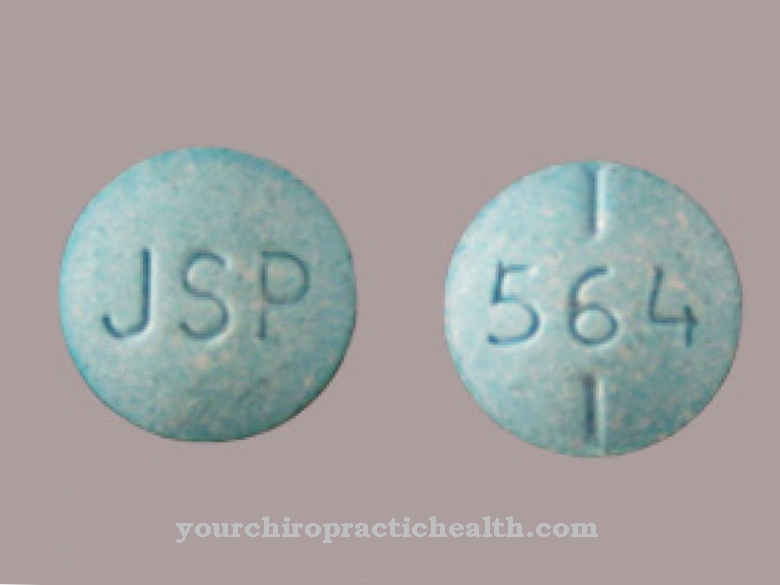Amantadine is used as an active ingredient in influenza A and Parkinson's syndrome. It is only available on prescription and under various trade names, mostly in the form of tablets and also as an infusion.
What is amantadine?

The drug amantadine is a derivative of adamantane. It is suitable for the treatment of influenza A flu infections and Parkinson's disease. This makes it one of the groups of antivirals and anti-Parkinson drugs. It is mainly prescribed in tablet form that contain 100 mg, 150 mg or 200 mg of the substances amantadine hydrochloride or amantadine hemisulfate. The attending physician determines the dose and dosage form individually.
Another possible application is a suspected positive influence of amantadine in the treatment of withdrawal symptoms in cocaine addicts. The drug is also used in the treatment of multiple sclerosis.
Pharmacological effect
The active ingredient amantadine inhibits the release of viral hereditary information into the cytoplasm of the host cell and thus blocks the M2 ion channel protein present in the cell membrane. This effect can only be achieved with a therapeutic dose of amantadine in the case of influenza A type flu viruses. A possible mutation of the M2 gene can result in virus resistance to amantadine.
To effectively combat influenza B viruses and other such viruses, amantadine would have to be overdosed, which is why it is not used here.
The exact mechanism of action of amantadine in Parkinson's disease is not yet completely clear. It is believed that, as a weak antagonist of the MNDA glutamate receptor type, it increases the release of dopamine and thus prevents the reuptake of dopamine. It has a positive effect in the treatment of Parkinson's disease.
It has also proven itself in drug-induced Parkinsonism and combined with L-DOPA for the treatment of L-DOPA-related dyskinesias. A reduction in Parkinson’s symptoms can be observed after administration of amantadine.
Medical application & use
Amantadine works by preventing viruses from multiplying and relieving the symptoms of Parkinson's disease.
The drug amantadine can be used preventively in unvaccinated and vaccinated people if there is a risk of infection with the type A flu virus. Amantadine can reduce the duration of the fever by about a day if the flu is already caused by the influenza A virus. In addition, it reduces the feeling of illness that is otherwise pronounced in "real" flu. It is best to prescribe Amantadin as soon as possible after the flu occurs in order to develop its full potential. It should be taken one to two days after the symptoms have stopped.
Amantadine for the prevention and treatment of virus type A flu should only be used in children from the age of 5 years. In the elderly, the drug should be dosed carefully, especially in delirious patients and those with agitation and confused states. Treatment with amantadine is not recommended for pregnant and breastfeeding women.
In Parkinson's therapy, amantadine reduces the typically increased activity of the acetylchoninergic striatal interreurons. As a weak NMDA receptor antagonist, it also inhibits the effect of glutamatergic projections from the cortex. The exact mode of action of amantadine in the treatment of Parkinson's disease is not yet fully understood. The results are still convincing. Amantadine noticeably alleviates the obvious symptoms associated with this disease. It reduces tremors - tremor, it reduces movement disorders - akinesia, and it reduces physical rigidity - rigidity.
Risks & side effects
When taking amantadine, patients may experience various side effects, the frequency of which is described as uncommon:
- Mood impairments such as euphoria or depression
- Impairments to perception such as confusion, nightmares or hallucinations
- sleep disorders
- Urination disorders
- Nausea, vomiting, or diarrhea
- Fluctuations in blood pressure
The ability to drive and work with machines may be impaired by reduced alertness and possibly reduced eyesight during therapy with amantadine.
Because of the complex interactions with numerous drugs, the attending physician must be informed about the use of other drugs. Amantadine should also be used with caution in a wide range of chronic and acute diseases.
Amantadine is contraindicated in:
- Hypersensitivity to the active ingredient
- Heart failure in stage NYHA IV
- Cardiomyopathy and myocarditis
- AV block II. And III. Degree
- Bradycardia
- congenital QT syndrome and related heart diseases
- Cardiac arrhythmia
- low levels of calcium and magnesium in the blood
























.jpg)



